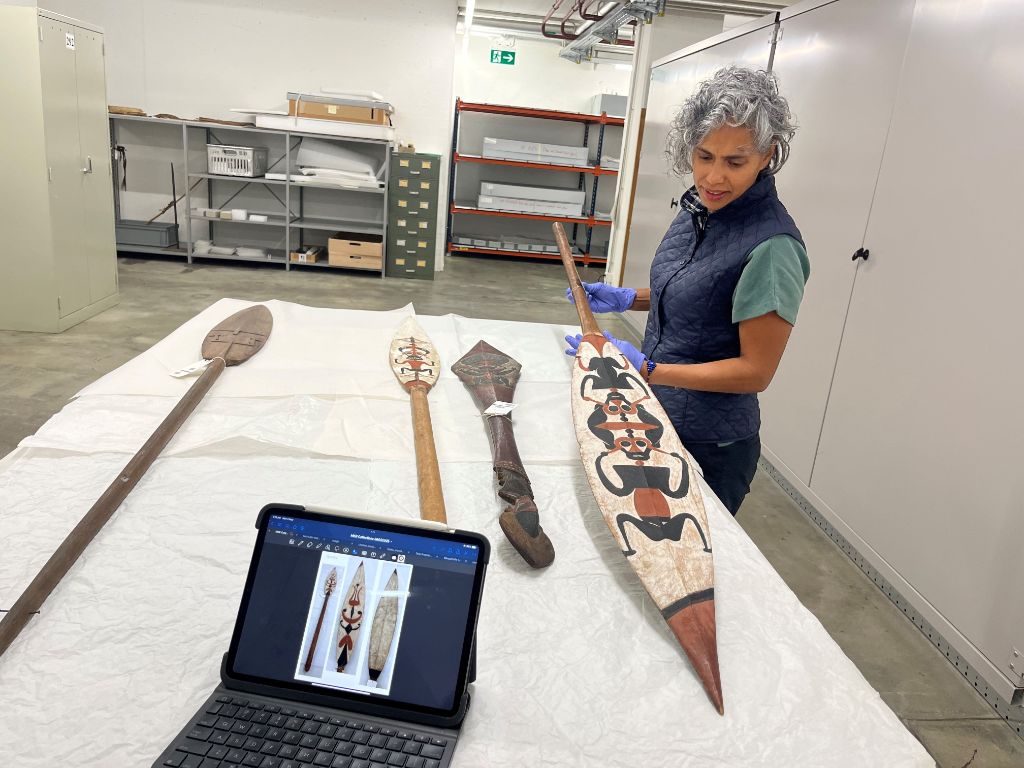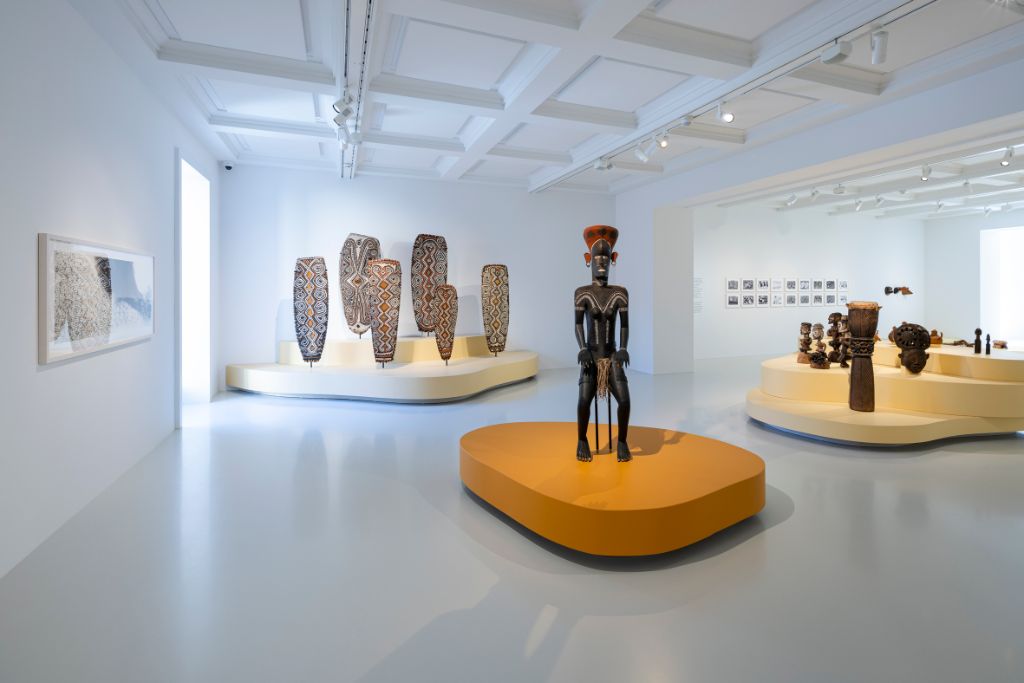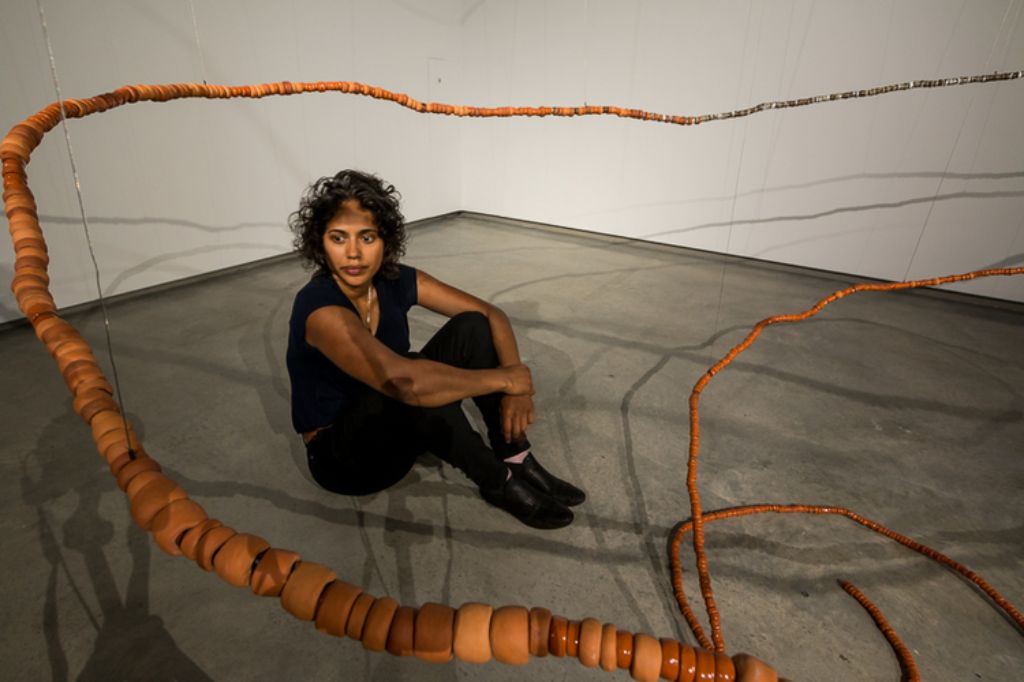Cross-cultural learning
Taloi Havini* is an artist and curator from Bougainville. She has been working with the collection of the MKB from this region during the last few months. Participating in the project “In Full View” she will present results of her research in the museum and engage with visitors.
MKB: How come that you are doing research at the museum?
Taloi Havini: I am here because there is a very impressive and unique collection within the Museum der Kulturen Basel, paralleled with the museum’s openness to connect directly with communities where these collections originate.

Taloi Havini is holding a Buka paddle from the MKB collections © Anna Schmid
You are dealing with the collection from Bougainville. What does this mean to you?
The fellowship has provided me the time to research in-depth some of the earliest “artefacts” that arrived in Europe from Oceania. Including regions not only from my ancestral islands of the north Solomon Islands archipelago but also items and archives culturally significant from the region of the earliest colonial times.
It also means a great deal to live here and understand the context of how they came to be here in Basel in terms of a historic context and a contemporary context. For example, I am a very fortunate individual to have arrived at the time of Fasnacht, to have experienced Basel and this cultural practice that is very important to the people of Basel. I feel enriched for this rather come by as a fleeting collection visit. I also appreciate that this allowed me to be a local and be accessible to community and have research days with the collections, archives, libraries, provenance, and curators.
What does the collection you work with consist of?
The MKB has some of the finest examples of currency, ceremonially significant items, trade and art collected from the Solomon Islands archipelago from the early 20th century.

In the exhibition «Alive»: kesa, the sculpture of a queen of the Naka- and Naboin-goups from Bougainville
What have you been you doing so far?
The collection period that I am researching looks into the early 20th century. By then Germany’s influence had made economic inroads but had also lost their dominance. The era of these collections reflects the time of who’s cultural practices (collectors) believed indigenous people were in “extinction” and rapid depopulation from competing colonial regimes. The collector’s intentions of the day were preoccupied with seeking the most rare, unique, forbidden or “taboo” examples of “primitive cultures” that were far from their own.
The research Fellowship at the MKB has really inspired me in my arts practice – making new work for the exhibition and having the support of Chus Martínez and her faculty at the Institute Art Gender Nature, Basel Academy of Art and Design FHNW.
It is the first time an artist works on full view in the museum. How do you feel about it?
I am excited, mainly because museums and the collections they hold are important to society. Museum practices that engage the collection with people from the regions they originate is a form of valuing the cultural heritage that exists. It is also a kind of cross-cultural learning. How else will I know what the public think about what these collections mean to them? It will be a good story to go back and inform my community too.

Taloi Havini is inspecting porcelain fired ceramics at the Campus Workshops, HGK Basel FHNW © Ruth McDougall
What can visitors expect?
A room with art, carvings, various forms of currency and shell money. I have selected items from the North Solomon collection that is unique only to this part of Oceania. There will also be some of my own books, archives and artwork (moving images) and pieces of the MKB-archives, chosen together with the provenance team. I can imagine there will be some questions around why such fine historic examples of art from my ancestors are here in Basel. Visitors can enter a space where generative conversations are encouraged. I might not have all the answers, and I think this is a good thing to embrace. In working with collections, I find raising questions happens more often over having definitive answers.
What do you expect?
I am keen to see how people will encounter the collections and as I will be present, this may provide more in-depth engagement, not to parade as an expert on culture, but rather as someone who’s main profession is in making art and as a researcher. I like to have an open-minded approach when having conversations with people about collections. For instance, we can talk about their origins and collecting histories, or the ways in which certain objects were viewed in colonial times and then now. We can also discuss the meanings behind some of the design-work and materials used.
Taloi Havini will be exhibiting at Art Basel (19-22 June 2025):
“For Art Basel’s Unlimited section, I have produced a new version of my earlier sculptural installations titled “Beroana” (shell money). This iteration of Beroana reimagines the materiality and form of what currency can look like. It will be a suspended installation, mimicking the shape of an open pit mine and this shape also references the earthenware vessels that used to conceal ceremonial money from public view.
In previous editions I sourced clay from the southern hemisphere. Collected by KADIST, Queensland Art Gallery | Gallery of Modern Art, and the Sharjah Art Foundation. Whereas in this edition I used porcelain from France, Germany, the United Kingdom and China.
Meanwhile, in “In Full View” I will have a selection of what is normally held within MKB’s storage, the real currency used in pre-colonial times. I am excited that shell money in the traditional form and the contemporary will be on display for the public to access across both platforms in Basel this June.”

Taloi Havini and her piece of art Beroana © Bob Miller
*About Taloi Havini
Born in the Autonomous Region of Bougainville, Taloi Havini (Nakas/ Hakö tribe) is based in Brisbane, Australia. Taloi is an interdisciplinary artist. Knowledge production, inheritance, mapping, and representation are core themes of her research practice. Often engaging with museum collections and archives her works are shaped by her matrilineal ties to her homeland where she collaborates with living cultural practitioners to explore environmental, social, and political issues. Major commissions and exhibitions include Ocean Space, Venice; Dhaka Art Summit, Bangladesh; Palais de Tokyo, Paris; Sharjah Biennial 13; 9th Asia Pacific Triennial of Contemporary Art, QAGOMA, Brisbane; Answer to the Call, der TANK, Basel. Taloi Havini is winner of the Artes Mundi 10 prize in 2024, collected by Sharjah Art Foundation, Art Gallery of New South Wales (AGNSW), National Gallery of Victoria and the Queensland Art Gallery (QAGOMA).